#Osechi (Japanese traditional cuisine for new year)
Photo

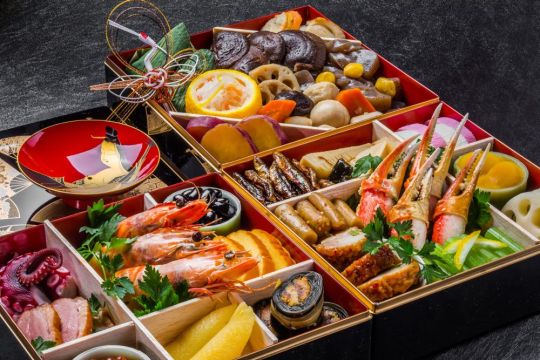
Japanese New Year Tradition: Osechi Ryōri
In Japan, starting off the New Year is more about spending time with family than it is about partying. It's a time of year when people go back to their home towns, pay their first visit to the local shrine, and sit down to some traditional food. And food doesn't get more traditional than osechi ryōri.
The tradition behind osechi ryōri (お節料理) goes back centuries, to the Heian period (794-1185). Ritual offerings of food used to be presented to the gods on sechinichi, or days that marked the changing of the seasons according to traditional Chinese almanacs that were used during this time. The most important sechinichi, of course, was the day that marked the beginning of the New Year. On this day, special dishes were offered to various deities, and also eaten by members of courtly society.
Over the centuries, these traditions made their way to the rest of society, and by the Edo period (1603-1868), they were being practiced commonly around Japan. They combined with other beliefs, notably that on the first days of the New Year, any kind of work — including cooking — was to be avoided. There are two competing theories as to why this was the case. One was that the gods shouldn’t be disturbed by the sounds of cooking on the first days of the year, and the other is simply that the beginning of the year was meant to be a time of rest, when everyone — particularly the women of the household, who did most of the work around the home in those days — could enjoy a well-deserved break.
In the beginning, osechi was quite simple food — vegetables boiled in soy sauce and vinegar — but over the centuries, more and more types of food were added to the osechi ryōri lineup, turning it into a much more elaborate affair. Almost all of these dishes have a special meaning, related either to the name of the food in Japanese or to its appearance or other special characteristics. These are some of the most commonly eaten dishes, and their associated meanings:
Kuromame (黒豆)
Black beans are meant to be a symbol of health, with the associated idea that the person who eats them will be able work hard in the year to come.
Kazunoko (数の子)
This dish is herring roe, but the symbolism is connected both to the large number of tiny eggs, and to the meaning of the Japanese words. Kazu means “number” in Japanese, and “ko” means “children.” The wish behind this item is that the next year will bring many children. For an extra layer of meaning, look to the name of the fish in Japanese: the word for herring is nishin, and if it’s written with an alternate set of kanji (二親), it means “two parents.”
Tazukuri (田作り)
This dish is sardines boiled in soy sauce. Historically, sardines were used to fertilise rice fields, and this word means “rice field maker” in Japanese. Symbolically, this food is eaten in the hopes that the coming year’s harvest will be plentiful.
Kohaku Kamaboko (紅白かまぼこ)
Kamaboko is a kind of fish cake, and kohaku means red and white. The colours represent Japan (most easily found on the country’s flag), and are generally considered to be good luck. According to some, the red colour is meant to prevent evil spirits, while white represents purity. Incidentally, Kohaku Uta Gassen is one of the most popular TV shows that Japanese people watch on New Year’s Eve, and it’s a singing competition between two teams comprising of the most popular singers in Japan — the white (male singers) and the red (female singers).
Datemaki (伊達巻)
This is an omelette mixed with mashed shrimp or hanpen (fish paste). It tastes a little bit different from the tamagoyaki that you might be used to, but it’s rolled into a similar shape, which happens to look like a scroll from the side. That’s why this particular food is associated with learning and scholarship.
Kurikinton (栗きんとん)
These are sweet dumplings that are made from chestnuts. Because they’re yellow in colour, they’re associated with gold, and eating them is meant to bring financial prosperity in the year to come.
Kobu (昆布)
This is a type of seaweed, and this word is closely connected to the word yorokobu, or happiness, which is what this food is meant to bring in the New Year.
Tai (鯛)
Sea bream; the symbolic meaning here is something of a play on words. Tai is part of the Japanese word medetai, meaning happy or joyous. This fish is often eaten on special occasions, and it’s one of the dishes that is served as okuizome, the traditional food that a baby is fed about 100 days after he or she is born. In osechi, it’s meant to bring joy and happiness in the new year.
Shrimp (海老)
The kanji for shrimp mean “old man of the sea,” playing on the sea creature’s bent back and antenna that look like whiskers. This food is meant to bring longevity.
Satoimo (里芋)
Also known as taro root, this dish is eaten in the hopes that the family will be blessed with many children — just like many small taro tubers grow off of the main tuber.
Renkon (蓮根)
Known as lotus root in English, this vegetable has very distinctive holes when it is cut in cross sections. Because you can see clearly when you look through these holes, this food is eaten in the hopes of having a future with no obstacles — or at the very least, obstacles that you can see clearly.
Just as it goes with any tradition, not every dish is eaten at every household, and some dishes fall out of favour over time – sometimes because younger people don’t particularly enjoy eating them, or because tastes change. (One newish item that you’ll find in osechi ryōri spreads, although it doesn’t have any special meaning yet, is roast beef.) The osechi dishes are, for the most part, served in elegant lacquer boxes known as jubako.
Some families prepare the osechi themselves, while others choose to order theirs from department stores or convenience stores. For those who wish to purchase a beautifully crafted osechi for their New Year’s celebrations, department stores like Takashimaya and Keio stores offer fantastic options — though they certainly don’t come cheap!
#Japanese New Year#Osechi Ryori#お節料理#Osechi#Japanese Cuisine#Sanganichi#Japanese Tradition#New Year#Osechi Ryōri#Japanese Food
31 notes
·
View notes
Note
Also wanted to add for the Soft Sunday: New Year edition
Osamu: In the southern United States we have a little new year cooking tradition eating Black eye peas and greens for good luck and prosperity in the new year. You share that tradition with him, but y’all come up with a variety of ways to eat black eye peas and greens. Even mix and match his culture cuisine and yours together to make something new. That in itself becomes a tradition for y’all.😁
Happy eating y’all!!

Soft Sunday: Happy New Year
With: Osamu Miya

Hey, if there's a food related custom you follow, Osamu is all about it. He loves learning new cuisines, especially specialty foods for holidays. He is going to experiment a lot with the black eye peas and greens before New Years actually rolls around to see what works and what doesn't. On New Years Day, he'll give you a traditional Japanese Osechi box with all those southern ingredients incorporated into it somehow. He will be a little shy at first because he doesn't want to spoil the holiday with bad food. Hopefully you like it though!

#soft sunday#happy new year#obitobridgade♥#best moot squad#Osamu Miya x Reader#Osamu Miya headcanons#Haikyuu x reader#Haikyuu headcanons
17 notes
·
View notes
Text
Creativity (1/2)
Cooking
Today, the 1st of January 2023 is a special day in every Japanese household as its a national holiday and there are many special traditions occurring on this day, including cooking and eating a traditional New Year's cuisine called Osechi. As it always takes time and experience this year I decided to help my mom prepare it. It took quite a lot of effort and time but it was definitely worth it as the food was exquisite and the time spent with your loving family was also delightful.

0 notes
Photo

“Osechi” are traditional Japanese cuisine which are eaten on New Year’s Day. 我が家の2023年度の自家製おせち料理。 お重が三つではまず足りないので いくつも追加で盛り付けます。 それでも具材は盛り切れておりません (笑) こどもがとても楽しみにしている年中の行事の特別なお料理。 日本は特に、年末が忙しく クリスマスも料理料理三昧で すぐに来る年末にお正月料理で大忙し。 食材の調達も大変でして 生鮮食品を多様に仕込みますので 本当に大変ですね。 ですが、やはり手作りおせちと買ってきた予約でのおせちなどとは 美味しさが格別に違うものです。 それらを知っている我が家のこどもは 味覚ともども、感性豊か。 食の幅広さを持っているので とても人間関係においても柔軟性が高くとても柔らかい。 たくさんたくさん頂きました。 明日はまたおせちを楽しみつつ 『中トロ鉄火』なども仕込んで 夜は焼肉やお刺身や色々を楽しみたいと思います。 手作り料理がどんどんなくなっているので 本当に貴重だと、喜ばれる私の手料理です。 もちろん完全無添加のちゃんと手作りって貴重です。 人件費は私が調理致しますのでかかりませんが しっかりと原価がかかると言う。。。。(笑) 今回は海老も超特大でたっぷりに 2種類の海老料理を出しました。 非常に美味美味。 料理研究家 指宿さゆり ーーーーーーーーーーー #料理研究家指宿さゆり #レシピ開発 #レシピ制作 #レシピ制作専門スタジオ #料理は教養 #食は品性 #年末のご挨拶 #インスタグルメ #obento #happynewyear #無添加 #料理好きな人と繋がりたい #インスタ映え #インスタフード #フォトジェニック #手作りおせち #新年のご挨拶 #数の子 #手作りおせち #お正月料理 #おせち料理 #フードスタグラム #神戸料理教室 #神戸グルメ #重箱 #お節 #煮しめ #元旦 #正月三が日 #新年 (神戸市) https://www.instagram.com/p/Cm38Txpy_mx/?igshid=NGJjMDIxMWI=
#料理研究家指宿さゆり#レシピ開発#レシピ制作#レシピ制作専門スタジオ#料理は教養#食は品性#年末のご挨拶#インスタグルメ#obento#happynewyear#無添加#料理好きな人と繋がりたい#インスタ映え#インスタフード#フォトジェニック#手作りおせち#新年のご挨拶#数の子#お正月料理#おせち料理#フードスタグラム#神戸料理教室#神戸グルメ#重箱#お節#煮しめ#元旦#正月三が日#新年
0 notes
Photo
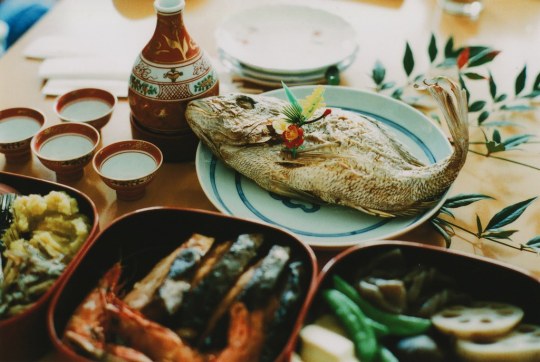
Osechi (Japanese traditional cuisine for new year) by masatoo_hirano
11 notes
·
View notes
Text
Takeru’s 155 Q&A
To start off things, let me share (again) one of my most satisfying works from last year, that is Takeru’s Q&A section from his 30th birthday anniversary book. Looking back, I think I worked on this one for almost one week, and It felt really satisfying to finish it on Takeru’s 31th birthday ❤️
Once again, enjoy!
(Disclaimer: All translations are done by myself, pls don’t repost without permission, thank you!)
===========
These are the questions sent by fans through Takeru's official LINE account. Thank you for all of your participation!!
1. Is there anything you would like to do or achieve in 2019?
I'd like to do anything good for my body
2. If there is one day you're not Satou Takeru anymore, what will you do?
Go to sauna
3. If there is one day you become a girl, what will you do?
Sing Sheena Ringo's songs in the original key
4. If you can travel back in time, when would you go?
Middle high school
5. If you are being reborn, do you want to be yourself again?
Not really
6. If there is an "Anywhere Door", where would you like to go?
The world's best views
7. Do you think aliens exist?
Not in this solar system I think
8. 10 years from now, what kind of father do you want to be?
I want to avoid using weird emoji
9. If you move abroad, which country would you choose?
Maybe America or Canada
10. If you got the chance to direct a film, what kind of film and who are the casts?
Horror. Because it seems difficult to explain, I'll do it myself.
11. If you have to become one of the characters you've played before, who will you choose?
Shishigami Hiro
12. Among of the movies created in the past, is there any movie you like to have acted in?
(Anything from) Ghibli
13. Who would you like to meet the most right now? And what will you ask him/her?
Hanyu (Yuzuru)-kun. "Do you want to join Amuse (Takeru's agency)?"
14. Anything you want to overcome in this year?
Coughing out when sleeping
15. If you can go with your mom on a trip, where would you like to go?
I don't know. I'll go where she would want to go
16. When you see food with the name you see for the first time, do you dare try? Or you tend to play safe?
I tend to take the challenge.
17. If you can meet your 20-year-old self, what would you like to say?
Nothing in particular
18. What kind of present you would like to receive in last year of Heisei-era?
Speakers that can be used in bathroom
19. Where would you like to go on honeymoon?
The world's best views
20. What would you like to do in your last day of your life?
I don't want to know that day is the end of my life
21. If you can take a long holiday, what would you like to do?
Watch movies. Escape room games.
22. I love Takeru-kun's singing voice. If someday you get to sing in your next project, do you want to do it?
I don't mind
23. If you weren't in the entertainment world, what would you do?
I imagined myself to study something related to science-field in university, but I don't know what to do next
24. What else you like in sushi other than Kohada (gizzard shad)? Between tuna and salmon, which one do you like?
Tuna. I also like squid and uni (sea urchin). And also button shrimp
25. If you become an invisible person, what would you want to do?
State secrets investigation
26. Favorite movie?
Kimi no Na wa (Your name)
27. Do you like sweets?
I like it but I rarely snacking
28. Favorite smell?
Morning forest
29. What do you like in osechi (traditional Japanese new year food)?
Kamaboko (fish cake)
30. Favorite manga?
Tenshi na Konamaiki (Cheeky Angel)
(note: he said in Yakai before that his first love is the heroine from this manga XD)
31. Do you like to go to onsen?
Yes
32. If you have your own favorite/most disliked body parts, please tell us!
I won't say because it's embarassing
33. Favorite color?
Navy blue
34. Favorite kind of noodles?
Cold soba
35. Favorite season?
Winter
36. Do you like horumon (cuisine made from pork or beef offal)?
I like it more than average people
37. You went to lots of places during filming or doing promotion for movies, do you have favorite region? Also please tell us if you have a must-eat food there!
Hitsumabushi in Nagoya
38. If i remembered correctly, you've said that you like your home, is there any other place you like?
I also like hotel
39. Any recommendation for foreign drama?
Friends
40. Favorite novel?
Shigatsu ni nareba Kanojo wa (also titled April Girlfriend - by Kawamura Genki)
41. What do you usually add when you eat medamayaki (fried egg)?
Salt and pepper or Shoyu
42. What do you usually add when you eat freshly cooked white rice?
Karashi (spicy) mentaiko
43. Please tell us your order of eating sushi!
Omakase (literally meaning "I'll leave it up to you", a special course when the customer leaves it up to the chef to serve)
44. What are your memories of doing Kamen Rider?
Commuting in a crowded train
45. Please tell us a happy episode from filming Den-O!
We sometimes would go to Jojoen near Oizumi Studio
46. Who is your favorite Imajin from Den-O?
Ura(taros)
47. If you act as (Nogami) Ryoutarou right now, what kind of person you think he will be?
I think people will not change that much
48. If you have a child, what name will you give him/her?
I think 2 letters would be nice
49. Among the actors-actresses you haven't co-starred with, who would you want to work together with?
Fukatsu (Eri)-san
50. Among all of your projects, which role is the most fun/memorable?
Rookies was fun
51. Do you still continue to learn English?
Yes
52. Among all of roles you've played, was there a moment when you think it resembles yourself?
Probably no
53. Is there any place inside Japan you want to go?
Never-visited islands
54. Is there anything you want to learn right now?
I want to learn to dance
55. When you first meet a person, what is the first thing you will look at?
I got this question a lot and until now I don't know the answer. I wonder what I will look at first
56. What role you want to try this year?
As a runaway child
57. Among all of your projects, is there anything you wouldn't want to watch?
Basically I don't want to watch it. I don't watch most of it.
58. If you can do a sequel, is there a work you want to do?
Rurouni, Kanouso, Gibomusu
59. Is there any villain role from movie/drama/manga/novel that you want to do?
I'd like to if there's any (interesting roles)
60. Before you do a crying scene, how do you usually spend your time?
Depends on the scene
61. What is your description of "Kakkoii"?
Taking the initiative in what people hate, and don't show off your action
62. You said that you didn't like saba no misoni (mackerel with miso), was it because you didn't like mackerel itself?
When I saw "saba no misoni" in school lunch menu, I would be very dissapointed. I like mackarel though.
63. If you got an offer for main cast in Taiga drama, will you take it?
I like that kind of question where you don't think "If it's the main cast for Taiga I'll definitely do it"
64. Something to do to keep you healthy?
Sleep 12 hours
65. Do you have any actor friends?
Everyone that gave their comments in this book
66. How do you feel when you work in Rurouni Kenshin
kiri (` ・ω・‘)
(note: this is the actual answer (i only changed hiragana to romaji/alphabet), kiri/kiru is to cut/slash in japanese, so maybe he just felt like slashing ppl all the time XDD)
67. Something that makes you feel "I can die peacefully after doing this"?
Become Ajin
68. What is the scariest thing in the world?
Please see video original version of "Ju-on"
69. Have you seen Aurora?
No
70. When you take a bath, what part of the body you washed first?
Head
71. In what moment do you usually can be yourself the most?
I am myself mostly everytime
72. If fans reach out to you in your private time, how far can we go e.g handshake/photograph?
It'll be embarassing to take a photo, so only handshake is good
73. We always see Takeru-san in the acting side, do you ever think of creating a movie?
If I create a movie, I also want to act in that movie
74. You showed us for a short moment in Horoyoi ads, but I want to hear more of your singing voice! Recently, is there any song that you will definitely sing in karaoke?
Marigold, no I'm lying. I don't have such song.
75. You always give your best during promotions for dramas/movies, but was there any tough times?
Ehh you're so kind.
76. You said that you want to take a break in this year because you've worked hard in last year, did that feeling change?
It's not like I want to take break, but I think my exposure level is decreasing compared to last year
77. In Kanouso, during the moment when you weren't supposed to cry but tears suddenly fell down, how to control such emotion?
I looked at her (Riko) face
78. Is there any actor/actress you admire?
If I tell you, you will be more aware of that person, so because I don't want you to have such thought, I won't tell you.
79. How did you spend your time during 2019 new year?
I watched Unnatural with my family at home
80. What is your special skill?
Othello
81. Do you use perfume?
I don't usually use it but because we're making it (as anniversary goods) this time so I'm using that.
82. When thinking about Takeru-kun, your image is strongly tied with solving riddles, how did you get into it? Also how much time did you spend in 1 day?
My first time was when my friends invited me to play escape games. As long as time allows me to do it, I can do it all day.
83. Among all of Hanbun, Aoi cast, who is your best friend?
Kan-chan (Suzume's daughter)
84. If you meet a person that you want to befriend, are you the type who reach out to him/her, or wait?
Reach out
85. Regardless of gender, what kind of person you're not good at?
People who makes mistakes
86. What is your decisive factor when choosing a project?
Whether I want or I don't want to do it
87. By any chance, is Takeru-san the type of genius person with photographic memory?
I'm not that kind of person
88. What do you sing when you go to karaoke?
Radwimps
89. Do you do any muscle training?
I do but depends on the timing
90. When you go out with somebody you like on a date, in what situation do you like?
Autumn leaves
91. Has anybody said to you that you resemble someone (in entertainment world)?
Shouhei's wife (Kiritani Mirei)
(note: why he won't say her name directly XDD)
92. Do you have any age restriction for marriage?
I'd like to do it in my 30s if I can
93. Why do you become "a man lost in love"?
What a good word to express it. Love is not something you experience several times, isn't it?
94. What kind of hair type do you like for girl?
I like natural, not shaped ones
95. In what moment do you think girls are cute?
When you see they are excited when I choose her in SUGAR
96. When you found a girl you like, do you actively "attack" her?
Of course if I like her
97. Do you like a woman who will casually do body touch, doing upward gaze, and sort of the aggresive type?
I don't like it at all
98. In what moment you think you can't help but liking a girl?
When she casually do body touch, do upward gaze
(note: so which one do you actually like LOL -- refer to Q97)
99. Between older and younger woman, which one do you like?
I like both
100. What kind of girl do you like?
Girls with narrow "strike zone"
101. What is the minimum requirement for your partner to marry you?
I no longer have such requirement
102. As a man, what do you think of a man who keeps looking at his phone, keeps looking at the clock when dating a woman?
It's not a good thing to do, it's like he doesn't care about his partner.
103. What do you think about a fun and easygoing girl?
Girls with good sense of humor are good
104. When you have a girlfriend, what kind of homemade food will you make for her?
Miso soup
105. What kind of make up do you like for girls?
As long as she doesn't overdo it
106. I have a person I can't forget even after so many years, Does Takeru-kun have that kind of experience?
Yes for a few years, but I don't know what will happen for 10+ years
107. I called my nephews and nieces with nicknames. Does Takeru-kun have any nicknames you want to be called with?
I like Takeru-san rather than Takeru-kun
108. What sound do you use as your alarm ringtone?
Default settings
109. You have a really beautiful skin. Do you have any advice for it?
Moisturizing
110. Any activities you've been into lately?
Alternate baths (also called contrast bath therapy)
(note: a kind of bath therapy where you alternate between hot and cold baths.)
111. Where do you usually go?
Most recent is gym
112. Do you still hate caterpillars?
Sorry, but yes
113. Do you cook? Do you have any specialities?
Nope
114. Where and how you usually memorize your script?
I usually memorize it with my costars moments before shooting in the set
115. For Takeru-san who loves reading, how do you usually choose books to read?
I'd usually pick friends' recommendation
116. When you sleep do you prefer to turn on or off the lights?
Turn off. I can't stand even the lights from humidifier
117. In what moment do you think it's nice being an actor?
When people are being nice to you
118. Things like clothes, bags, shoes, is there anything that you have to make sure it's in good quality before you buy?
Towel
119. If you have one full day with your beloved cats, what will you do?
Cuddling its cheek
120. If you are being reborn as a cat, who do you want to take care of you? Do you want to play together with Kochirou and Puchirou in Satou's family house?
Yes.
(note: Kochirou and Puchirou are his beloved cats currently living in his parents' house)
121. If you can have one more cat, what name will you give?
At least not names in katakana
122. Are you a dog person? Cat person?
Cat
123. As a cat-lover, which part of a cat do you like?
Face
124. What is your favorite Kochirou and Puchirou's pose?
When they become rounded like a ball
125. If you can have a dog, what kind of dog do you like?
Shiba-inu
126. Beside cat, do you have any other animals you'd like to have?
Dolphin
127. Where do you want to live?
Shiodome maybe
128. Have you give your mom presents from home bakery?
Yes. I think you can also make mochi with those
129. If you're doing a solo trip, where will you go?
Canada
130. How do you get along with Nobu-san (from Chidori)?
We were working together in a variety show and I ask for his phone number
131. You were famous among the older people from long ago, what do you think about that?
I don't really care about the age as long as I still got the "waa" and "kyaa"
132. In what moment do you feel happy?
When I solved a riddle
133. What is your favorite song from Takahashi Yuu-kun?
Hachigatsu Muika (August 6)
(note: he sang this song in his 30th birthday event)
134. If you have to give a score for your acting career up until now, how many points out of 100?
60
135. In the future, can you create an event where fans can meet you directly?
Yes
136. You've said before that because you can't tidy your room up so your mom had to visit your house to tidy things up, is it still the same now?
I've become independent now
137. I'm still a kid, an elementary school student. When I talk about Kamen Rider, there are some kids who get along with me, but there also kids who call me weird. Is it alright that I still love Kamen Rider? Please tell me.
I was also called weird by my friends in my school days so it will be alright
138. Do you plan to go to Kyoto in this year?
I already go there few times
139. In what moment do you feel the happiest?
I can't decide between the moment when I saw at Ruroken's (sales) performance or when I managed to clear an escape game challenge, or when I was in elementary school when I got into Yu-Gi-Oh, I got Summoned Skull from a booster pack.
140. Was there a moment when you cried while watching a movie?
Usually I cried watching touching movies
141. Between the roles you've played almost simultaneously, such as Ritsu in Hanbun, Aoi, Mugita in Gibomusu, and Kazuo in Oku Otoko, which one is the most difficult to play?
Kazuo
142. Recently, is there a moment when you laughed so hard?
I was hitting my knees laughing while watching Aiseki Shokudou (Chidori's show) at home
143. Please tell us an episode from Kouhaku!
When I hesitated to wave my penlight, but then I saw Nomura Mansai-san was waving his so I decided to follow
144. Please tell us your recommended places to visit from "Rurouni-hon Kumamoto e".
Nature is always recommended.
Negative ions are good for the body.
(note: "Rurouni-hon Kumamoto e" was a book about Takeru doing a trip in Kumamoto, promoting places especially those which were affected by Kumamoto earthquake. A portion of the sales were donated to support Kumamoto recovery)
145. You said in the past that you couldn't sleep for a long time, how is it now?
Hm it's complex but I think my internal body clock feels off
146. When telling our thoughts about your movies/dramas, do you have any preferred ways that makes you happy?
When you shared it in the internet
147. My son is telling me that he wants to be a voice actor and wants to go to a vocational school. As a parent, should I support him? Did Takeru-kun get your parents' support when you want to be an actor?
My parents had no objection at that time. It didn't cost me any money. By the way, do professional voice actors learn in vocational schools? I support him to become a voice actor, but I'm not sure if it's the right decision to enroll in a vocational school to become a voice actor.
148. Among all the places you've visited during your work or private trips, do you have any recommendation for us?
Salar de Uyuni
(note: he went to this place for X photobook)
149. When you watch a movie, do you prefer to read the original story first or straight to the movie?
If I want to enjoy the movie, I'd watch the movie first. If I want to enjoy the book, I'd read the book first.
150. Can I hug you when I meet you?
Maybe no
151. Do you use washing machine for drying your clothes? What will happen to your clothes after that?
Wrinkled
152. What is the most important thing or person to you?
People who put their faith in me
153. Are you looking forward to expand your career overseas?
Rather than wanting to work in a Hollywood movie, I prefer to think more on how to make Japanese movies more visible to the world.
154. Is there anything you'd like to do in your 30s, any target or resolution?
I have a few in mind, but I'll tell you when I manage to accomplish them
155. Please tell us about your vision of living your life from now on!
I hope I can do more of what I want to do.
(pic: https://satohtakeru.amuseblog.jp/blog/2019/03/30th-anniversar-1c47.html)

19 notes
·
View notes
Text
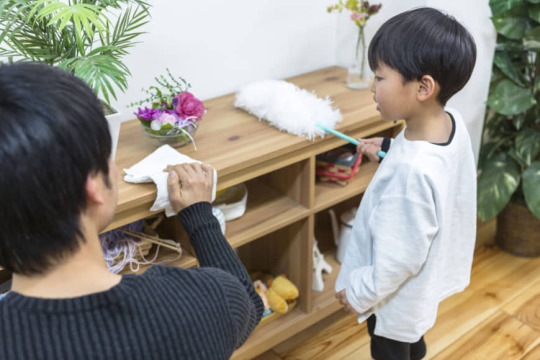
Cleaning house (and head) at the end of the year
BY DANIEL MORALES
It’s that time of year again, 年末 (nenmatsu, the end of the year) has arrived and with it come 年末行事 (nenmatsu gyōji, year-end rituals). This includes eating かぼちゃ (kabocha, pumpkin) and hopping in a ゆず湯 (yuzu-yu, yuzu bath) on 冬至 (tōji, winter solstice), getting your 年賀状 (nengajō, New Year’s greeting cards) in order, and cooking or ordering おせち料理 (osechi ryōri, traditional New Year’s cuisine) to eat on New Year’s Eve.
But the most important of these rituals is 大掃除 (ōsōji, year-end “big” cleaning). Families dust away the cobwebs from the 仏壇 (butsudan, family altar), deep clean the stove, bleach カビ (kabi, mold) off bathroom walls, and throw out 賞味期限切れ食品 (shōmi kigen-gire shokuhin, expired foods) to clear the fridge.
While 大掃除 is generally a physical activity, your humble scribe takes it metaphorically as well and engages in a mental 片付け (katazuke, tidying up) of sorts. This involves a good soak in the お風呂 (o-furo, bath) and long walks through the city, but today I want to straighten up some of my digital documents.
Over the course of the year I’ve accumulated all sorts of notes, phrases and vocabulary words that I intended to use in articles. These are little nuggets that have been clinking around in my head for a while, and now it’s time to find them a home and clear the slate for the new year.
For example, the phrase もらってくれて (moratte-kurete). I’ll hold off on providing the English for just a moment so that you can delight in the Japanese construction as I did when I first heard it. We have a verb of receiving もらう (morau, to receive) plus a verb of giving くれる (kureru, to give), both in their て-form? What is going on here?
Here’s a little context: I was waiting for an elevator with a coworker and he reached out with a piece of candy in his hand and said this.
My coworker was using the imperative of くれる to ask/request that I give him something. What did he want me to give him? Think of the more familiar casual imperative phrase 助けてくれて (tasukete-kurete, help me) used when someone is asking for help. Similar to this construction, my coworker was asking me to give him the receiving of the candy. He didn’t want it anymore and was basically saying “Take it for me.”
Another note I have lying around is a phrase I remember from a teacher I worked with on the JET Program: お願いできますか (O-negai dekimasu ka, Could I ask you a favor?). I remember him using it on the phone all the time and thinking it was a brilliant softening phrase that can be used before making a request of someone your level or lower (although not a superior).
Just swap it out for お願いできればと思います (o-negai dekireba to omoimasu, I was hoping I could ask a favor) when speaking with a superior.
A couple of my leftover notes are related to similar small switches in the language that can help with politeness, so that must have been something I was focusing on this year.
Some of these are as simple as remembering new vocabulary: I was trying to find a polite way to ask someone if they were able to attend an event and 来られますか (koraremasu ka, are you able to come?) didn’t feel polite enough. I settled on お越しいただくことは可能ですか (o-koshi itadaku koto wa kanō desu ka, is it possible for you to come?), which relies on leveling up 来る (kuru, to come) to お越しになる (o-koshi ni naru, honorific polite version of “to come”).
It’s important to remember that sometimes you need to do more than just swap out vocabulary for polite speech; occasionally you’ll need a change in attitude. For example, I also found a note to myself not to use 残念ながら (zannennagara, unfortunately) when sending someone bad news; instead, use 申し訳ありません (mōshiwake arimasen, I’m sorry).
While it might feel odd to be apologizing if you haven’t done anything wrong or if the bad news is entirely out of your control, this will often feel more “Japanese.” Apologizing will acknowledge how the person is feeling (likely frustrated) and help smooth over their feelings and prepare them to receive the information you need them to understand.
And that’s it for my 2019 notes. Now that I’ve cleared out my backlog, I feel すっきりした (sukkiri shita, refreshed). I’m ready for 2020 and all the linguistic challenges and pleasures it will bring.
43 notes
·
View notes
Text
Happy New Years

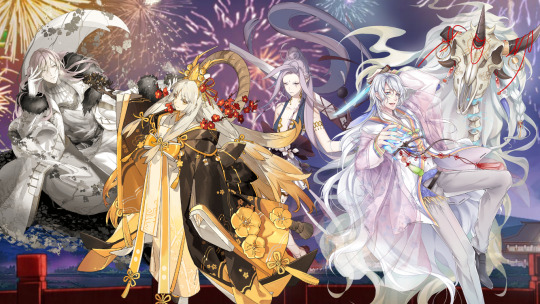
Osechi: Osechi has been a traditional Japanese new year food since the Heian period and is very strongly tied to that holiday. It is recognizable by its special box which is similar to a bento box in storage and functionality. Originally the Japanese New Year was celebrated according to the solar/lunar calendar known as the Tenpō calendar, and some of the traditional festivities are still celebrated according to that system, although officially the Gregorian calendar is used as of 1873.
The name Osechi comes from o-sechi, meaning a season/important time, New Year's day was one of the five seasonal events of the Kyoto imperial court. During the first three days of the new year, people weren’t supposed to cook most meals so osechi was made at the close of the old year to be eaten during that period. Although it was originally quite simple, osechi has become more varied over the centuries and now the many dishes that can be found in it can also reflect well wishes for the new year such as kuro-mame and ebi. Traditionally osechi is made at home, although in modern times it can be found in many stores.
Toso: Toso is a spiced rice wine considered medicinal that is a staple part of the new year's osechi cuisine in Japan. The recipe is said to have originally been a prescription by the famous Chinese physician Hua Tuo during the third century, it began appearing in Japan around the 9th century. The ingredients have changed over time but now it typically contains Japanese pepper, cinnamon, ginger, rhubarb, amongst others. there are also multiple regional drinking ceremonies associated with its consumption.
Toso is drunk to wash away the previous year's toxins and maladies, not just for the drinker but for those around them, it is also thought to promote longer life. The kanji toso is written with even reflect this, 蘇 representing evil spirits and 屠 meaning to defeat. Toso first became associated with the New Year during the Edo period, when pharmacies started giving out tososan to their patients as a year-end gift. At home, the patients could soak the tososan in some sake, and then drink the sake, hoping that it would give them good health in the New Year. The custom is now mainly limited to Kansai and west Japan; as people in other regions more often drink sake at new years without the herbal mixture.
Champagne: Champagne is a French sparkling wine, and although many people use the term Champagne as a term for any sparkling wine, in many countries it is illegal to label any product Champagne unless it is produced under the rules of the appellation. It is produced from specific types of grapes grown in the Champagne region following rules that demand, among other things, specific vineyard practices, sourcing of grapes exclusively from designated places within the region, specific grape-pressing methods and secondary fermentation of the wine in the bottle to cause carbonation. The genuine product is a drink help to a high standard even to this day as it often still can not be mass-produced efficiently.
The lavishness of champagne dates back to the 16th century. European aristocrats would pop the bottles at their royal parties, making the drink an “elite” item to have and to drink. After the French Revolution, it became a part of the secular rituals that replaced formerly religious rituals. The drink came to be opened at weddings, baptisms and other religious events. As the price declined in the 1800s the developing middle classes could begin to afford it, not as a table drink but still for celebrations, one of them being new years. Some suggest the drink became so tied to the holiday has a form of symbolically christening the new year, but many also argue that this drink is just very enjoyable and the tradition was born of celebrating that on the holiday.
Tteokguk: Tteokguk is a traditional Korean dish eaten during the celebration of the Korean New Year. The dish consists of the broth/soup with thinly sliced rice cakes. The broth is generally made by simmering the main protein in a ganjang-seasoned stock, the stock is then strained to make it more clear and long cylinder-shaped garaetteok are thinly sliced diagonally and boiled in the clear broth. Garnish is added before serving, but will often vary by region and personal taste. Although tteokguk is traditionally a seasonal dish, it is now eaten at all times of the year.
It is tradition to eat tteokguk on New Year's Day because it is believed to grant the consumer good luck for the year. The New Year custom of eating tteokguk is speculated as being originated from ancient times, The white tteok signifying purity and cleanliness would be eaten as a ritual to start off the New Year for good fortune. In Korea, on New Year's Day, a family performs ancestral rites by serving tteokguk to their ancestors during a joint meal as well. The Korean New Year is different from the Gregorian New Year, being about a month later as it is determined with a lunar calendar, culturally it is also very different as you are thought to become a year older on this day rather than the anniversary of your birth.
Honorable Mentions -
Bibimbap: Bibimbap is a Korean rice dish, the term "bibim" means mixing various ingredients, while the "bap" noun refers to rice. It has existed in Korea for centuries and even is still often enjoyed today. Its creation came to be from early rural Koreans taking leftover vegetables, sometimes having meat, with rice and mixing them in a bowl. People ate bibimbap on the eve of the Lunar New Year as the people at that time felt that they had to get rid of all of the leftover side dishes before the New Year, but the dish has a very large history independent of that fact.
Fondant Cake: Some people have a tradition of placing three candles on a new year's cake as a way to wish for health, wealth, and happiness in the oncoming year. I had thought this was a thing many people did but I could not find it’s source or replication during my research.
Soba: Toshikoshi Soba, or year-crossing noodle, is a Japanese traditional noodle bowl dish eaten on New Year's Eve. It symbolizes letting go of the hardship of the year because soba noodles are easily cut while eating. Long noodles are thought to be a sign of long life, and soba, in general, are often associated with strength and health. This is an honorable mention because it is a specific type of cooking soba while the in-game soba seems to be the noodles in general.
Sakura mochi, Kashiwa mochi, Hishi mochi: Mochi are often eaten at new years although all of our in-game examples are already designated to different celebrations. Sakura mochi is to celebrate spring, specifically when cherry trees bloom. Kashiwa mochi is to celebrate Children's Day and Hishi mochi is for the Hinamatsuri Festival (otherwise known as Girl’s Day), two celebrations also during the spring.
--
I would like to note that yes Korean New Year is still a bit away but I felt it would be best to do now since otherwise Tteokguk and BBB might be alone or stuck with all of the Chinese Lunar New Year food souls awkwardly. With that said, Happy New Year everyone and good luck to you all in the oncoming year.
#food fantasy#ff history bits#ff edits#ff bibimbap#ff champagne#ff fondant cake#ff hishi mochi#ff kashiwa mochi#ff osechi#ff sakuramochi#ff soba#ff toso#ff tteokguk#happy holidays everyone
5 notes
·
View notes
Photo
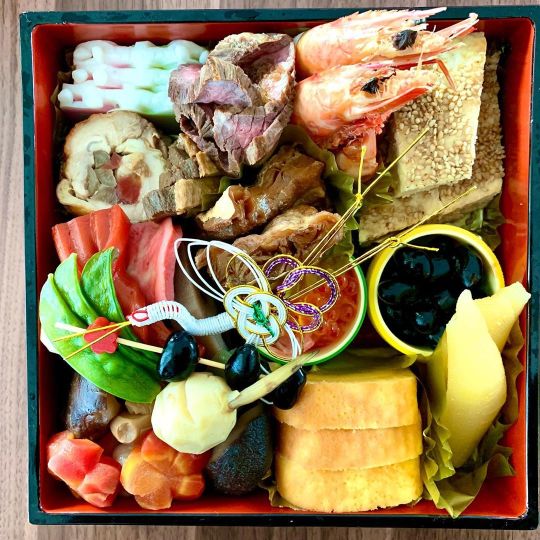
Happy New Year! Speaking of what to eat in New Year in Japan, "Osechi" A lot of good luck food! "Osechi", packed with Japanese traditions, is the culmination of Japanese cuisine! If you have the opportunity, eating is highly recommended! All the dishes in "Osechi" have a meaning related to "lucky" so it's fun! Thank you always! There are a lot of new items in my eBay store. You may find your favorite! If you don't have a favorite in my eBay store, let me know! We will do our best to find the items you like! There is an eBay Store link on my profile so please come and visit! #osechi #osechiryori #japanesefood #asianfood #washoku #oishii #itadakimasu #nihon #japan #japanese #lovejapan #beautifulcuisines #buzzfeast #buzzfeedfood #eeeeeats #feedfeed #huffposttaste #thekitchen #foodandwine #BHGfood #feastagram #instafood #soba #sushi #japon #foodie #foodlover #travel #traveljapan #sake (Kyoto, Japón) https://www.instagram.com/p/B6zSWw3A4lH/?igshid=1xr5eh8trptuz
#osechi#osechiryori#japanesefood#asianfood#washoku#oishii#itadakimasu#nihon#japan#japanese#lovejapan#beautifulcuisines#buzzfeast#buzzfeedfood#eeeeeats#feedfeed#huffposttaste#thekitchen#foodandwine#bhgfood#feastagram#instafood#soba#sushi#japon#foodie#foodlover#travel#traveljapan#sake
1 note
·
View note
Photo
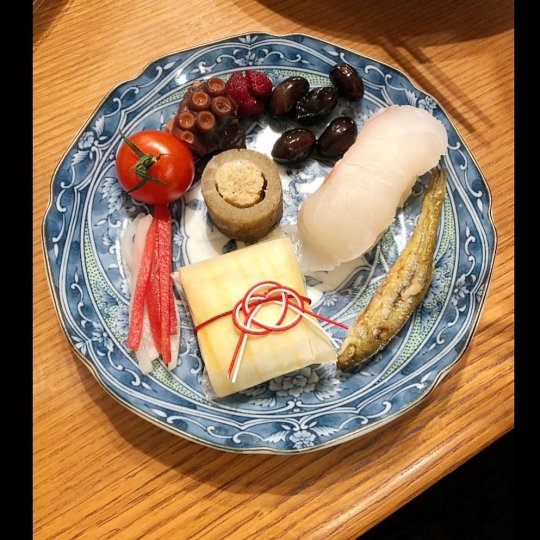
#fbf to enjoying Osechi-ryōri and all kinds of interesting traditional Japanese new year foods this year. Osechi ryori, or New Year’s cuisine, is usually preserved food that can last for several days, so no one has to cook. Osechi is deep with cultural symbolism. This meal is meant to be shared with the gods and even has special chopsticks with no handle called iwaibashi to use. The foods typically include: - sweet black beans - red and white "Kōhaku Namasu" pickled daikon - simmered octopus tentacles - dashimaki egg rolls - shrimp - Buri teriyaki - Kohaku Kamaboko fish cakes - red carrots - fried Tazukuri sardines - bamboo shoots - Kazunoko herring egg cakes - Sato-imo potatoes - and many many more. Shrimps are eaten to pray for a long life until you have a bent back and long beard like a shrimp. Other new years foods that we enjoyed included: - Ozoni soup with roasted mochi cakes - Daifukucha tea aka hojicha roasted tea full of thin strips of kombu sea kelp and small umeboshi pickled plums - lots of different Namagashi sweets to drink with tea. #京都 #正月 #おせち料理 #おせち #黒豆 #生菓子 #大福茶 #お雑煮 #食べ物 #美味しい #エビ #紅白なます #japan #japanesefood #japanese #culture #newyear #newyears #osechi #food #tea #sweets #traditional #shrimp #daikon #japaneseculture #kyoto #kyotojapan (at Kyoto, Japan) https://www.instagram.com/p/CaHOkZ4lDxj/?utm_medium=tumblr
#fbf#京都#正月#おせち料��#おせち#黒豆#生菓子#大福茶#お雑煮#食べ物#美味しい#エビ#紅白なます#japan#japanesefood#japanese#culture#newyear#newyears#osechi#food#tea#sweets#traditional#shrimp#daikon#japaneseculture#kyoto#kyotojapan
0 notes
Text
1st January, 2022
“Osechi”
It’s a Japanese traditional cuisine and it’s eaten in early the year.
Many foods in some boxes, like shrimps, beans, baked eggs and some vegetables and sea foods.
It seems that each foods have a meaning, for example, for a health or for a promotion.
I don’t remember what meaning they have though.

When I was younger, I didn’t know how delicious they are because they are too bitter a little for children.
Now I’m thirty, It has become delicious.
By the way, to make it is difficult since we have to prepare many foods.
So we often order it.
A few years ago, I heard that a bad company sent almost hollow boxes to people had ordered.
It was a terrible news story.
0 notes
Photo

Japanese New Year Tradition: Eating Zōni
Eaten on New Year’s Day, this soup dish has many variations. It usually consists of chicken and various vegetables, and sometimes tofu as well. It’s almost always eaten with mochi in it. The vegetables can range from carrots, shitake mushrooms, daikon, etc.. The mochi represents longevity, due to its stretchy form.
Historically, zōni is of samurai cuisine. The dish was cooked during battles and was very important for restoring a samurai’s strength between skirmishes.
The tradition of eating zōni on New Year’s Day began during the mid 1440s. The Japanese offered mochi to the gods and Buddha on Omisoka, or New Year’s Eve. This allowed there to be a fully prepared and ready ingredient to eat on New Year’s Day. To rest up and have an easily preparable meal, the Japanese would then consume this mochi the next morning in a soup!
#Japanese Tradition#Zoni#Japanese Cuisine#Osechi Ryori#Japanese New Year#Ozoni#Ozouni#New Year#Zouni#Sanganichi#Zōni#Ozōni#Japanese Food
3 notes
·
View notes
Photo
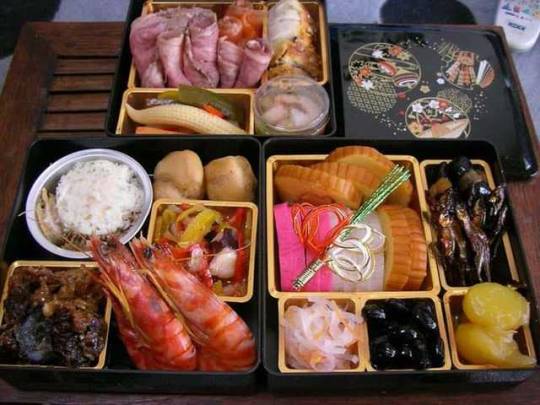


Osechi - Traditional New Year's Japanese Cuisine
On New Years, Japanese people go back to their hometowns and spend a few days celebrating and relaxing with their extended families. During this time, it's traditional to eat osechi - but what makes up this intricate set of dishes?
https://matcha-jp.com/en/710
44 notes
·
View notes
Text

We participated in YCS online party. At this party, special guest taught some Osechi cuisine receipes. Osechi cuisine is cooked for new year's days, and traditional Japanese seasonal cuisine. One of them was Tadukuri's recepe. It bothered us for some years because it was easy to stick together. But we found how to avoid its sticking together when she cooked it. Our sauce was thicker than hers. It was useful, and we enjoyed this party very much. Anyway, I had 梨山高山茶during this party.
0 notes
Text
JAPAN

a brief history :
Japanese cuisine has been influenced by the food customs of other nations, but has adopted
and refined them to create its own unique cooking style and eating habits.
The first foreign influence on Japan was China around 300 B.C. , when the Japanese learned to
cultivate rice. The use of chopsticks and the consumption of soy sauce and soybean curd (tofu)
also came from China.
The Buddhist religion, one of the two major religions in Japan today (the other is Japan
Shintoism), was another important influence on the Japanese diet. In the A.D. 700s, the rise of
Buddhism led to a ban on eating meat. The popular dish, sushi (raw fish with rice) came about
as a result of this ban. In the 1800s, cooking styles became simpler. A wide variety of
vegetarian (meatless) foods were served in small portions, using one of five standard cooking
techniques. All foods were divided into five color groups (green, red, yellow, white, and
black-purple) and six tastes (bitter, sour, sweet, hot, salty, and delicate). The Japanese continue
to use this cooking system.
Beginning in the early 1200s, trade with other countries began bringing Western-style influences
to Japan. The Dutch introduced corn, potatoes, and sweet potatoes. The Portuguese introduced
tempura (batter frying).
After a ban of more than one thousand years, beef returned to Japan during the Meiji Period
(1868–1912). Western foods, such as bread, coffee, and ice cream, become popular during the
late twentieth century. Another Western influence has been the introduction of timesaving
cooking methods. These include the electric rice cooker, packaged foods such as instant
noodles, instant miso (fermented soybean paste) soup, and instant pickling mixes. However, the
Japanese are still devoted to their classic cooking traditions.
popular dishes :
The most important holiday in Japan is the New Year, Shogatsu. Special holiday foods, called osechi , are prepared in beautifully decorated stackable boxes called jubako. Each layer of the box has compartments for several different foods. Glazed sardines, bamboo shoots, sweet black beans, and chestnuts in sweet potato paste are just a few of the many holiday foods. New Year foods are also eaten because they are believed to represent good fortune or long life. At New Year's, children are especially fond of hot rice cakes dipped in sweet soybean powder.
The Girls' Festival (or Doll Festival) is held in March. Dolls are dressed in traditional Japanese dresses called kimonos and are offered rice crackers, colored rice cakes, and a sweet rice drink called amazake . Everyone in the family eats the foods. Festive foods for Children's Day (May 5) include rice dumplings stuffed with sweet bean paste.
The tea ceremony ( cha-no-yu ) is an important Japanese ritual that can be held on a holiday or other special occasion. Developed over several centuries, it plays an important role in Japanese life and culture.
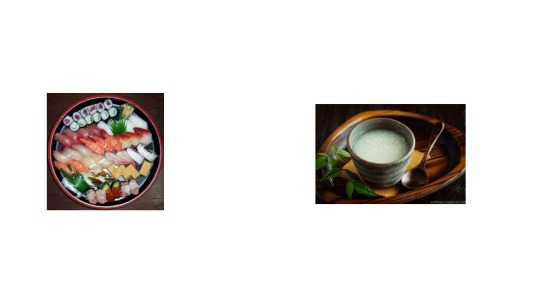
0 notes
Photo
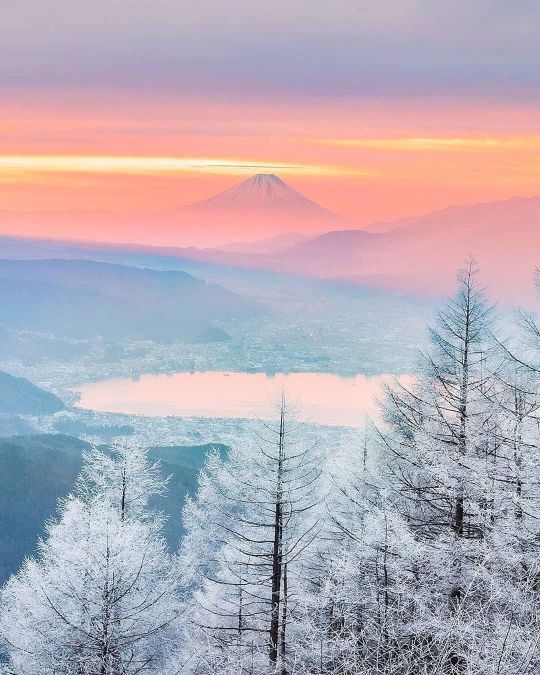
I❤️🇯🇵 repost @visitjapanjp ・・・ Happy New Year from everyone here at JNTO! 2020 is going to be an incredible year for Japan, and we're excited to share it with everyone! Do you have plans to visit the Land of the Rising Sun this year? If so, we want to hear them! Here are some essential ways to celebrate New Year's Day in Japan! 1) Hatsumode: join locals for the "first shrine visit of the year." You will see people getting in line at shrines before midnight to pay their respects to the gods. If you are lucky, the shrine might even serve some warm amazake (an non alcoholic rice drink) or sake! 2) Omikuji: find out your fortune for the next year! These little paper fortunes (like the one in the picture) are usually in Japanese, but Sensoji Temple in Tokyo, Naritasan Shinshoji Temple in Chiba Prefecture, Nishiki Tenmangu Shrine in Kyoto, and Tsurugaoka Hachimangu Shrine in Kamakura are known for providing English versions. 3) Osechi: this Japanese cuisine contains assorted traditional dishes, and is served in a box similar to bento. Each ingredient holds a particular meaning and symbolizes good fortune for the year ahead! 4) See the sunrise: active types might want to hike up to one of Japan's many mountain shrines to see the first sunrise of the year. Just be sure to bundle up to keep warm! Watching Mt. Fuji appear in the sunrise is another popular option. Incredible photo courtesy of @ko_ion9117. Follow @visitjapanjp for your daily dose of Japan travel inspiration. Tag your own photos of Japan with #visitjapanjp to give us permission to repost! #japan #japantravel #visitjapanjp #visitjapan #travelspiration #traveling #travelgram #instatravel #travelpic #doyoutravel #japantrip #landscapes #naturephotography #japanlovers #seetheworld #experiencejapan #discoverjapan #nagano #newyears #newyearseve #newyearsinjapan #mountfuji #sunrise #welcome2020 #yearoftherat #happynewyear https://www.instagram.com/p/B6y0BreAaQ0/?igshid=1il2jrkxagx6l
#visitjapanjp#japan#japantravel#visitjapan#travelspiration#traveling#travelgram#instatravel#travelpic#doyoutravel#japantrip#landscapes#naturephotography#japanlovers#seetheworld#experiencejapan#discoverjapan#nagano#newyears#newyearseve#newyearsinjapan#mountfuji#sunrise#welcome2020#yearoftherat#happynewyear
0 notes